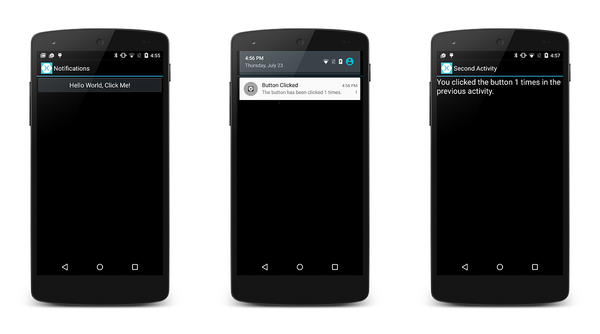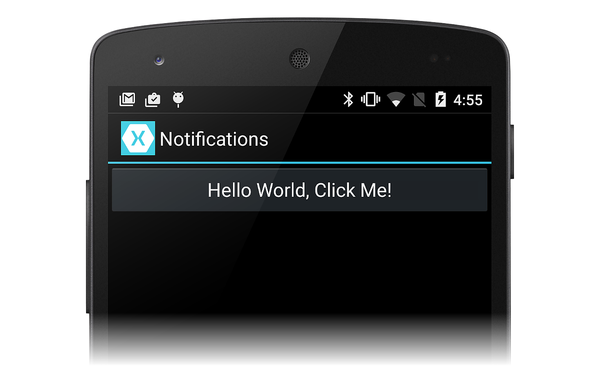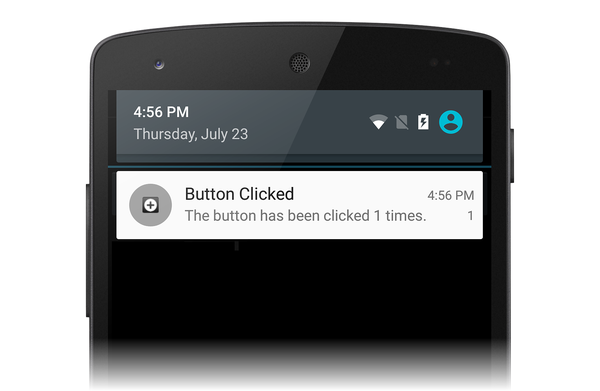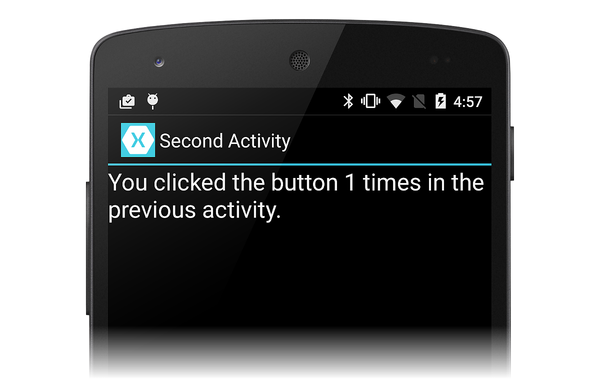演练 - 在 Xamarin.Android 中使用本地通知
本演练演示如何在 Xamarin.Android 应用程序中使用本地通知。 它演示了创建和发布本地通知的基础知识。 当用户单击通知区域中的通知时,会启动第二个活动。
概述
在本演练中,我们将创建一个 Android 应用程序,该应用程序当用户单击活动中的按钮时引发通知。 当用户单击通知时,它会启动第二个活动,该活动显示用户在第一个活动中单击按钮的次数。
以下屏幕截图演示了此应用程序的一些示例:
注意
本指南重点介绍 Android 支持库中的 NotificationCompat API。 这些 API 将确保与 Android 4.0(API 级别 14)的最大后向兼容性。
创建项目
首先,让我们使用 Android 应用模板创建新的 Android 项目。 让我们调用此项目 LocalNotifications。 (如果不熟悉创建 Xamarin.Android 项目,请参阅你好,Android。)
编辑资源文件 values/Strings.xml,使其包含两个额外的字符串资源,这些资源将在创建通知通道时使用:
<?xml version="1.0" encoding="utf-8"?>
<resources>
<string name="Hello">Hello World, Click Me!</string>
<string name="ApplicationName">Notifications</string>
<string name="channel_name">Local Notifications</string>
<string name="channel_description">The count from MainActivity.</string>
</resources>
添加 Android.Support.V4 NuGet 包
在本演练中,我们将使用 NotificationCompat.Builder 生成本地通知。 正如本地通知中所述,必须在项目中包含 Android 支持库 v4 NuGet,才能使用 NotificationCompat.Builder。
接下来,让我们编辑 MainActivity.cs 并添加以下 using 语句,以便我们的代码可以使用 Android.Support.V4.App 中的类型:
using Android.Support.V4.App;
此外,必须让编译器清楚地知道,我们使用的是 TaskStackBuilder 的 Android.Support.V4.App 版本,而不是 Android.App 版本。 添加以下 using 语句以解决任何歧义:
using TaskStackBuilder = Android.Support.V4.App.TaskStackBuilder;
创建通知通道
接下来,为 MainActivity 添加一个方法,用于创建通知通道(如有必要):
void CreateNotificationChannel()
{
if (Build.VERSION.SdkInt < BuildVersionCodes.O)
{
// Notification channels are new in API 26 (and not a part of the
// support library). There is no need to create a notification
// channel on older versions of Android.
return;
}
var name = Resources.GetString(Resource.String.channel_name);
var description = GetString(Resource.String.channel_description);
var channel = new NotificationChannel(CHANNEL_ID, name, NotificationImportance.Default)
{
Description = description
};
var notificationManager = (NotificationManager) GetSystemService(NotificationService);
notificationManager.CreateNotificationChannel(channel);
}
更新 OnCreate 方法以调用此新方法:
protected override void OnCreate(Bundle bundle)
{
base.OnCreate(bundle);
SetContentView(Resource.Layout.Main);
CreateNotificationChannel();
}
定义通知 ID
我们的通知和通知通道需要一个唯一的 ID。 让我们编辑 MainActivity.cs 并将以下静态实例变量添加到 MainActivity 类:
static readonly int NOTIFICATION_ID = 1000;
static readonly string CHANNEL_ID = "location_notification";
internal static readonly string COUNT_KEY = "count";
添加代码以生成通知
接下来,我们需要为按钮 Click 事件创建新的事件处理程序。 将以下方法添加到 MainActivity:
void ButtonOnClick(object sender, EventArgs eventArgs)
{
// Pass the current button press count value to the next activity:
var valuesForActivity = new Bundle();
valuesForActivity.PutInt(COUNT_KEY, count);
// When the user clicks the notification, SecondActivity will start up.
var resultIntent = new Intent(this, typeof(SecondActivity));
// Pass some values to SecondActivity:
resultIntent.PutExtras(valuesForActivity);
// Construct a back stack for cross-task navigation:
var stackBuilder = TaskStackBuilder.Create(this);
stackBuilder.AddParentStack(Class.FromType(typeof(SecondActivity)));
stackBuilder.AddNextIntent(resultIntent);
// Create the PendingIntent with the back stack:
var resultPendingIntent = stackBuilder.GetPendingIntent(0, (int) PendingIntentFlags.UpdateCurrent);
// Build the notification:
var builder = new NotificationCompat.Builder(this, CHANNEL_ID)
.SetAutoCancel(true) // Dismiss the notification from the notification area when the user clicks on it
.SetContentIntent(resultPendingIntent) // Start up this activity when the user clicks the intent.
.SetContentTitle("Button Clicked") // Set the title
.SetNumber(count) // Display the count in the Content Info
.SetSmallIcon(Resource.Drawable.ic_stat_button_click) // This is the icon to display
.SetContentText($"The button has been clicked {count} times."); // the message to display.
// Finally, publish the notification:
var notificationManager = NotificationManagerCompat.From(this);
notificationManager.Notify(NOTIFICATION_ID, builder.Build());
// Increment the button press count:
count++;
}
MainActivity 的 OnCreate 方法必须进行调用以创建通知通道,并将 ButtonOnClick 方法分配给按钮的 Click 事件(替换模板提供的委托事件处理程序):
protected override void OnCreate(Bundle bundle)
{
base.OnCreate(bundle);
SetContentView(Resource.Layout.Main);
CreateNotificationChannel();
// Display the "Hello World, Click Me!" button and register its event handler:
var button = FindViewById<Button>(Resource.Id.MyButton);
button.Click += ButtonOnClick;
}
创建第二个活动
现在,我们需要创建另一个活动,当用户单击通知时,Android 将显示该活动。 将另一个 Android 活动添加到名为 SecondActivity 的项目。 打开 SecondActivity.cs 并将其内容替换为以下代码:
using System;
using Android.App;
using Android.OS;
using Android.Widget;
namespace LocalNotifications
{
[Activity(Label = "Second Activity")]
public class SecondActivity : Activity
{
protected override void OnCreate(Bundle bundle)
{
base.OnCreate(bundle);
// Get the count value passed to us from MainActivity:
var count = Intent.Extras.GetInt(MainActivity.COUNT_KEY, -1);
// No count was passed? Then just return.
if (count <= 0)
{
return;
}
// Display the count sent from the first activity:
SetContentView(Resource.Layout.Second);
var txtView = FindViewById<TextView>(Resource.Id.textView1);
txtView.Text = $"You clicked the button {count} times in the previous activity.";
}
}
}
还必须为 SecondActivity 创建资源布局。 在项目中添加名为 Second.axml 的新 Android 布局文件。 编辑 Second.axml 并粘贴以下布局代码:
<?xml version="1.0" encoding="utf-8"?>
<LinearLayout xmlns:android="http://schemas.android.com/apk/res/android"
android:orientation="vertical"
android:layout_width="fill_parent"
android:layout_height="fill_parent"
android:minWidth="25px"
android:minHeight="25px">
<TextView
android:text=""
android:textAppearance="?android:attr/textAppearanceLarge"
android:layout_width="fill_parent"
android:layout_height="wrap_content"
android:id="@+id/textView1" />
</LinearLayout>
添加通知图标
最后,添加一个小图标,该图标将在启动通知时显示在通知区域中。 可以将此图标复制到项目或创建你自己的自定义图标。 将图标文件命名为 ic_stat_button_click.png 并将其复制到 Resources/drawable 文件夹中。 请记得使用“添加”>“现有项...”将此图标文件包含在你的项目中。
运行应用程序
生成并运行应用程序。 应会显示第一个活动,类似于以下屏幕截图:
单击按钮后,你会发现通知区域中出现了通知的小图标:
如果向下轻扫并打开通知栏,应该会看到通知:
单击通知后,它应该会消失,而其他活动应该会启动 - 看起来有点像下面的屏幕截图:
祝贺你! 至此,你已完成 Android 本地通知演练,并有了一个可供参考的工作示例。 通知的内容远不止我们在这里介绍的这些,如果你想了解更多信息,请查看 Google 关于通知的文档。
总结
本演练使用 NotificationCompat.Builder 创建和显示通知。 它展示了如何启动第二个活动作为响应用户与通知交互的方式的基本示例,并演示了从第一个活动向第二个活动传输数据的过程。



